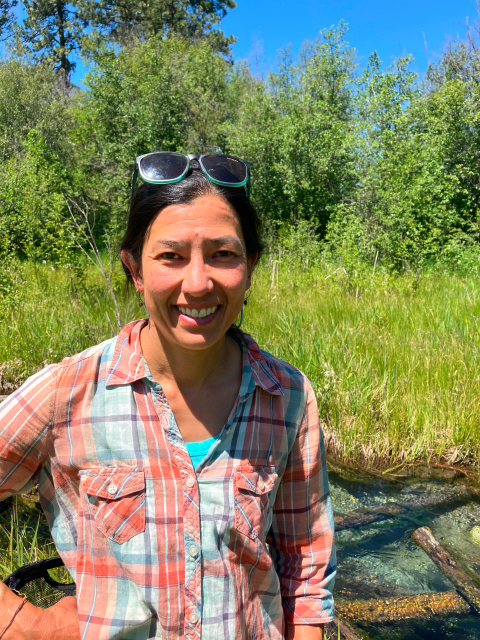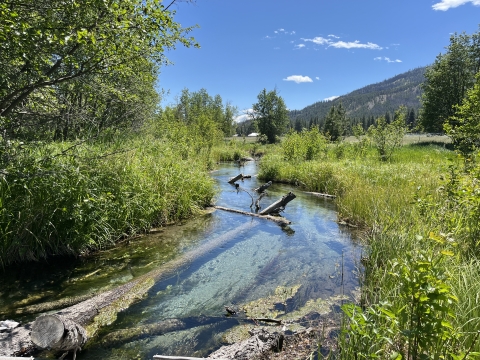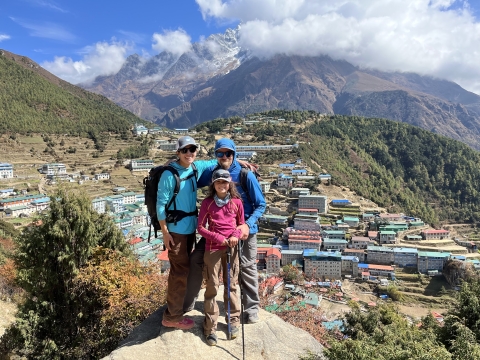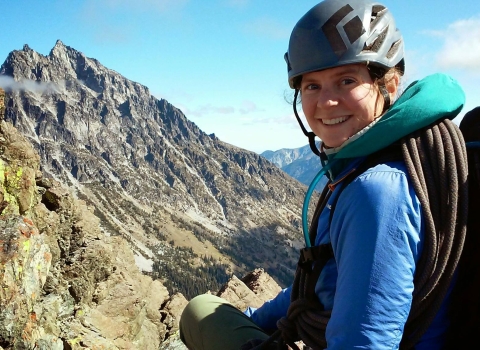By Jan Peterson, for the U.S. Fish and Wildlife Service
Tracy Bowerman was immersed in nature as a child. Her dad – a science teacher and nature center director – opened her eyes to the natural world around her and the animals that inhabit it. As an adult, she has continued to explore that world through many jobs, including her current career as a fish biologist for U.S. Fish and Wildlife Service’s Mid-Columbia Fish and Wildlife Conservation Office in the state of Washington. Here, she shares some of her adventures and how she built a career on doing what she loves.
Let’s start with where you started. Where did you grow up?
I grew up in a tiny resort town outside of Bend, Oregon, so my current home of Leavenworth, on the east side of the Cascade Mountains, feels very familiar to me. I did my undergraduate work in Vermont and Montana, then worked various field jobs in California, southern Oregon, Arizona, and Colorado as well as internationally before attending graduate school in Utah. I followed that with a post-doctorate position at the University of Idaho. So, I have lived in most of the Western United States at some point.
What sparked your interest in science and conservation?
I grew up a nature lover. My father was a science teacher and the director of a small nature center. He did everything from pest control to rehabilitating birds. I grew up in a house with a great-horned owl and two desert tortoises (both legally obtained), lots of fish and often salamanders, and sometimes other creatures such as a family of porcupines (not recommended; they are quite smelly), and a kestrel.
How did a kid curious about nature find her way to a career as a fish biologist?
I earned an undergraduate degree in biology but also had developed a passion for whitewater kayaking. So, after earning my undergrad degree, I looked for field biology positions that took me places where I wanted to go kayaking.
I studied parrots in the Amazon then headed south to explore whitewater in Patagonia. I worked on an insect study in Hawaii, and I traveled to Nepal to raise money for a girls’ education program called the Little Sisters Fund. I stayed on in Nepal to kayak some of its amazing rivers. I also taught whitewater kayaking on California’s Salmon River and in New Zealand.
Through these adventures, I realized I could merge my love of rivers with my love of nature, so I went to graduate school to study aquatic ecology.
How did you come to work for the U.S. Fish and Wildlife Service?
The Service helped support my doctoral research, and during that time, I worked with Howard Schaller and others at the Columbia River Fisheries Program Office. I appreciated the approach that the Service had for melding science with conservation. When I moved to Leavenworth, Washington, 10 years ago, I had my eye on working in the local field office. The fact the office is located on Nordic ski trails was an added incentive since I love cross-country skiing.
Could you tell us more about why it’s so important to be a mentor for young women in fisheries?
I was a presenter at a fish-passage meeting 10 years ago, and I remember sitting at the back of the auditorium looking around at the back of people’s heads. I was one of perhaps a dozen women in the entire room. It was striking how few women there were.
When I taught at the University of Idaho, there were only a handful of female undergrads in the fisheries program, and at different times, each of them made comments about how few women role models there were in fisheries. I realized it was important to help them see a path forward in the field, so I encouraged them to build their skills and helped them find jobs and graduate positions.
Who were some of your mentors? What are some of their lasting impacts?
I consider myself lucky to have had two amazing female mentors during my PhD work at Utah State University: my advisor, Phaedra Budy and engineer, Bethany Neilson. Both are no-nonsense people with high expectations for themselves and their students. They pushed me to be a better scientist and a better human.
Tell us about what you do at the Mid-Columbia Fish and Wildlife Conservation Office and some of the projects you’re working on.
I work on habitat restoration projects that range from fish passage fish passage
Fish passage is the ability of fish or other aquatic species to move freely throughout their life to find food, reproduce, and complete their natural migration cycles. Millions of barriers to fish passage across the country are fragmenting habitat and leading to species declines. The U.S. Fish and Wildlife Service's National Fish Passage Program is working to reconnect watersheds to benefit both wildlife and people.
Learn more about fish passage , such as replacing impassable culverts with fish-friendly bridges to improving habitat complexity and floodplain connectivity. There are many approaches we use to increase habitat complexity, including low-tech beaver dam analogues to large projects such as levee removal or hopefully removing Enloe Dam. Removing that dam in Washington would open hundreds of miles of cold water habitat ideally suited for Endangered Species Act-listed species such as spring Chinook [salmon] and Upper Columbia steelhead, along with other species such as summer Chinook and Pacific lamprey. Projects like the ones I work on are funded in part with $455 million allocated to the Service through the Bipartisan Infrastructure Law Bipartisan Infrastructure Law
The Bipartisan Infrastructure Law (BIL) is a once-in-a-generation investment in the nation’s infrastructure and economic competitiveness. We were directly appropriated $455 million over five years in BIL funds for programs related to the President’s America the Beautiful initiative.
Learn more about Bipartisan Infrastructure Law .
What do you find most rewarding?
I love the work I do and the people I get to work with. I love engaging with a community of people who are willing to think creatively and push for conservation of fish and wildlife. In my free time, I like growing my own food, mountain biking, running or hiking in the mountains, backcountry skiing and, of course, whitewater kayaking. I appreciate that I get to live and work in beautiful, wild places.
Is there anything else you’d like to share with us, personally or professionally?
My husband and daughter are also river enthusiasts. We took our daughter down the Lower Stikine River in Alaska when she was 18 months old. It rained nonstop for seven out of the eight days! Poor kid. She also recently ran the Karnali River in remote western Nepal. It was a massive expedition for an 8-year-old. She will obviously choose her own path in life, but right now I’m grateful that she enjoys spending time with us on rivers and exploring the natural world.
Our public lands, like our roads and bridges, require strategic investments and management to protect the fish and wildlife that is so important to the American public. The Bipartisan Infrastructure Law has committed $455 million to the U.S. Fish and Wildlife Service over five years to support our natural infrastructure and protect these valuable resources. This is a once-in-a-generation investment that will help local, state, and Tribal communities tackle the climate crisis while creating jobs, advancing environmental justice, and boosting local economies. By funding efforts to address intensifying drought, wildfires, flooding and legacy pollution, the law is the largest investment in the resilience of physical and natural systems in American history. Together we will build back better ecosystems and protect wildlife and wild spaces for the next generation.







